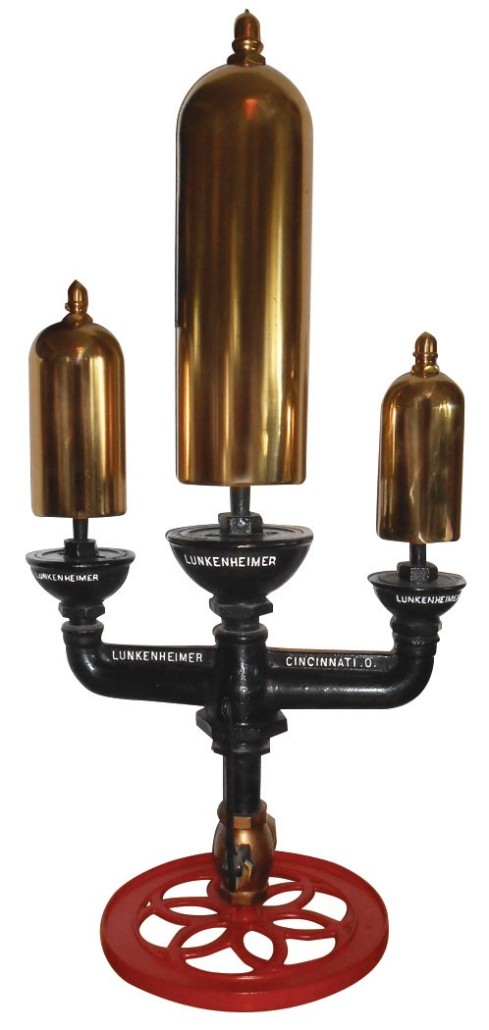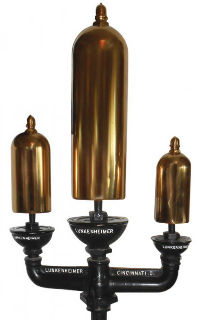
ILLIOPOLIS, Ill. (AP) – Billy Irvin can’t whistle-up the wind, but he knows how to sound out yesterday.
He is a collector and restorer of factory whistles, those steam-powered rooftop instruments that called the faithful to work for generations when reliable watches weren’t always within reach of everyone.
From the late Victorian period up through the 1950s, the brass and bronze whistles provided the soundtrack of working class lives: They signaled shift changes and lunch and, mercifully, time to go home.
“They were your worst enemy in the morning and your best friend in the afternoon, you know?” says Irvin, 35, who lives in the country near Illiopolis.
But often running on 150 pounds-per-square-inch of steam pressure and generating more than 100 decibels easily, it wasn’t just the workers who took notice.
Friends, Romans and countrymen outside the factory gates couldn’t help but lend them their ears, too, which is why whistles became the tweets and emails of their age, able to signal major events instantly.
Irvin has just finished a month-long project to restore the former Mueller Water Products Inc. Decatur factory whistle to its bronze glory. It now stands a gleaming but silent sentinel at the front entrance of the Hieronymus Mueller Museum and holds the memory of having been blasted to mark the end of World War I at 11 a.m on Nov. 11, 1918.
Decatur’s Review newspaper was entrusted with the job of actually confirming that the mass bloodbath in the war to end all wars had finally ceased.
“The Review will notify the Mueller factory, and the whistle will be sounded. All the other whistles in the city will then fall in the chorus,” according to a news clipping from the time anticipating the grand event.
Now, many of those factories of a century ago lie buried in the sound garden of history, along with their whistles. Irvin, a maintenance welder at Decatur’s Caterpillar Inc. plant, is part of a small, nationwide fraternity of whistle fans who hunt their quarry amid abandoned buildings and Internet sales.
“Before the personal computer, searching was kind of a crapshoot,” Irvin says. “The Internet has made it a thousand times easier.”
The master of a home workshop armed with a vast 1927 engine lathe, Irvin has the means and the skills to manufacture parts from raw brass and metal to save the whistles he finds. He had to make parts to fix the Mueller whistle and did it all for free, an intense labor of love.
“I appreciate what the Mueller Museum is doing for the community by preserving the past,” he says. “I think that is pretty important.”
What are the chances of a whistle expert walking into the museum one day, as Irvin did, and just happening to ask if they had the old factory whistle (it was stored in the basement) and then offering to fix it?
Laura Jahr, assistant museum director, is a big believer in the soundness of fate.
“It’s serendipity. We seem to get lucky over here in ways that we often can’t believe,” she says. “And, oh, what an amazing job Mr. Irvin did with our whistle, which would have been installed at the factory before 1900. You really need to come see it.”
Irvin’s own collection runs to 27 gleaming items, ranging from 21/2-inch-tall train cab whistles to 2-foot-long factory monsters in gleaming brass and bronze.
One circa 1918 specimen was saved from an old Pennsylvania Railroad workshop in Mingo Junction, Pa. This whistle sits outside his home and is connected to a compressed air supply and lets rip with a seven-second blast every day at 5 p.m. There are no neighbors nearby, which is just as well, as Irvin says he’s tested out the system and “can still hear it pretty plain from four miles away.”
Another of his whistles used to crown a psychiatric hospital in Buffalo, N.Y., and is a 24-inch column of bronze with a gaping red-painted mouth.
“It would signal shift changes but also had a darker use: if would be blown if there was an escape,” Irvin says.
The whistle resurrection specialist worries that what’s escaped us now is the whole bustling industrial era when factory whistles blasted forth their confident notes that told of lots of middle-class jobs chasing the American Dream.
“For such an simple item, there was so much behind whistles, and what they kind of represented,” he says. “An entire town could take pride in a busy factory.”
But not every whistle story has to end on a sad note. Irvin tells of a steam whistle that graced a former International Harvester plant in Canton that had been part of the soundscape of daily life there for generations. The remains of the hulking factory, which died in the 1980s, caught fire in 1997, but the then-mayor ordered that the whistle, known as “Big Toot,” be salvaged.
And when a company called Cook Polymer Technology came along to build its new plant on the old Harvester site, a working Big Toot was enshrined on the roof to thunderous applause on March 2, 2015. It now sounds daily at 8 a.m., noon and 5 p.m., and March 2 is known, by official proclamation, as “Big Toot Day” in honor of the generations that labored in the Harvester factory.
“A whistle that got to go home again,” Irvin says. “That’s neat.”
___
By TONY REID, (Decatur) Herald & Review
___
Source: (Decatur) Herald & Review, http://bit.ly/1QisM5G
___
Information from: Herald & Review, http://www.herald-review.com
Copyright 2016 Associated Press. All rights reserved. This material may not be published, broadcast, rewritten, or redistributed.
AP-WF-02-25-16 2318GMT



